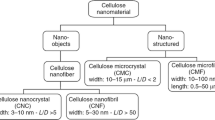
Overview
- Covers all recent aspects of nanocelluloses technologies, from experimental set-up to industrial applications
- Discusses the unique properties of nanocelluloses
- Highlights a wide range of industrial applications from biomedical applications to energy production and storage
Access this book
Tax calculation will be finalised at checkout
Other ways to access
About this book
This Handbook covers the fundamental aspects, experimental setup, synthesis, properties, and characterization of different nanocelluloses. It also explores the technology challenges of nanocelluloses and the emerging applications and the global markets of nanocelluloses-based systems. In particular, this book:
· Covers the history of nanocelluloses, types and classifications, fabrication techniques, critical processing parameters, physical and chemical properties, surface functionalization, and other treatments to allow practical applications.
· Covers all recent aspects of nanocelluloses technologies, from experimental set-up to industrial applications.
· Includes new physical, chemical and biological techniques for nanocelluloses fabrication, in-depth treatment of their surface functionalization, and characterization.· Discusses the unique properties of nanocelluloses that can be obtained by modifying their diameter, morphology, composition and dispersion in other materials.
· Discusses the properties and morphology of several kinds of dispersion in polymeric materials, such as micro/nanofiberlated cellulose, cellulose nanofibers, cellulose nanocrystals, amorphous cellulose nanoparticles, and hybrid cellulose nanomaterials.
· Presents the different techniques for dispersion, and self-assembly of polymeric materials, critical parameters of synthesis, modelling and simulation, and characterization methods.
· Highlights a wide range of emerging applications of nanocelluloses, e.g. drug delivery, tissue engineering, medical implants, medical diagnostics and therapy, biosensors, catalysis, energy harvesting, energy storage, water/waste treatment, papermaking, textiles, construction industry, automotive, aerospace and many more.
· Provides an outlook on the opportunities and challenges for the fabrication and manufacturing of nanocelluloses in industry.
· Provides an in-depth look at the nature of nanocelluloses in terms of their applicability for industrial uses.
· Provides in-depth insight and review on most recent types of nanocelluloses-based systems of unique structures and compositions.
· Highlights the challenges and interdisciplinary perspective of nanocelluloses-based systems in science, biology, engineering, medicine, and technology, incorporating both fundamentals and applications.
- Demonstrates how cutting-edge developments in nanofibers translate into real-world innovations in a range of industry sectors.
This Handbook isa valuable reference for materials scientists, biologists, physicians, chemical, biomedical, manufacturing and mechanical engineers working in R&D industry and academia, who want to learn more about how nanocelluloses-based systems are commercially applied.
Similar content being viewed by others
Keywords
Table of contents (33 entries)
-
Front Matter
-
Fundamentals
-
Front Matter
-
-
Nanofabrication
-
Front Matter
-
-
Processing
-
Front Matter
-
Editors and Affiliations
About the editor
Bibliographic Information
Book Title: Handbook of Nanocelluloses
Book Subtitle: Classification, Properties, Fabrication, and Emerging Applications
Editors: Ahmed Barhoum
DOI: https://doi.org/10.1007/978-3-030-89621-8
Publisher: Springer Cham
eBook Packages: Physics and Astronomy, Reference Module Physical and Materials Science, Reference Module Chemistry, Materials and Physics
Copyright Information: Springer Nature Switzerland AG 2022
Hardcover ISBN: 978-3-030-89620-1Published: 16 July 2022
eBook ISBN: 978-3-030-89621-8Published: 15 July 2022
Edition Number: 1
Number of Pages: XX, 1081
Number of Illustrations: 50 b/w illustrations, 230 illustrations in colour
Topics: Chemistry/Food Science, general, Organic Chemistry, Biochemistry, general, Materials Science, general



